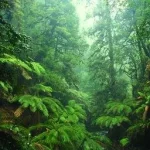Geography
As the five minutes were up, Dylan straightened his jacket and stood up again. As the few who had left the class came back and sat down again, Dylan opened: " Very well. As I said, part 1: ecosystems."
Dylan began his first slides, showing a variety of ecosystems, like forests, waterfalls, and even a desert. " What classifies any unique ecosystem, as geographers understand, is mostly the variety of features." Dylan began with zooming in on the forest.
" First, we shall examine the most diverse ecosystem on any habitable planet: the woodland. There exist a variety of different woodland classes: the most diverse is that of the tropical rainforest, which is characterized by high rainfall, that gives rise to nearly 60% of all biotic species within the known biospheres. They are characterized by a heavy canopy that prevents any sunlight to the forest floor, with only 2% passing through. Only plants accustomed to low light live on the floor, and the growth of fungi is rampant. This relative open floor allows for larger animals to life under the canopy."
" Beyond that are the temperate rainforests, that have more open canopies and the forest floor is more diverse. Despite that, only 10% of the light passes through, and a majority of the plants are still shade tolerant. Since rainforests require a steady supply of rainfall, they are mostly reserved to equatorial and coastal territories rich in either sea- or river- water." Dylan clicked next, showing a deciduous forest.

" Temperate forests are perhaps the most seen ecosystem of woodland. There are varieties that have broadleaf and mixed forests. Their canopies are mostly open, allowing a rich forest floor, and it is the place where most common animals are found, due to their rich nutritional properties. The further north or south of the equator, the less warm the forests are, and in the subarctic regions, these temperate mixed forest give way to boreal ones."
" Boreal forests consist almost entirely of coniferous trees, since the climate tolerates little broadleaf species. The forest floor is mostly characterized by the existence of permafrost, which makes the growth of plants nearly impossible. This is why the biosphere of these boreal forests is mostly dominated by furred animals accustomed to the cold."
Dylan then passed over to a multitude of climate maps. " Of all ecosystems, woodlands are perhaps the most susceptible to outside influence. Flooding, drought, weather extremes. And it is also the centre of civilized interference in nature. Throughout history, forests have suffered from fires by drought, harvesting for resources, and destruction by tornados and hurricanes."

" However, when encountered with natural disaster, forests can quickly regenerate, with saplings rebuilding the canopy in a matter of years. There is a difference, however, when civilization brings organised methods to alter forest grounds. With targeted cutting, burning down, and cultivation of former woodlands, forests have been reduced across planets for centuries. Nevertheless, when ecology came into existence, forest management created the means of not destroying, but rather repurposing forested areas. The creation of dedicated tree plantations has reduced the cutting of forests, and designated 'natural reserve' forests enjoy protection from environmental interference. In general, since rainforests protect more than half of most planetary biology, they are protected, while boreal forests are specifically planted for harvesting." With that, Dylan ended the part of the forests and moved on.




